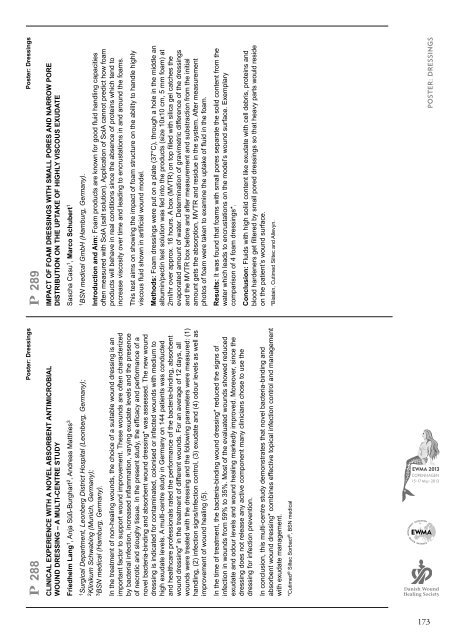Create successful ePaper yourself
Turn your PDF publications into a flip-book with our unique Google optimized e-Paper software.
POSTER: DRESSINGS<br />
Poster: Dressings<br />
P 288<br />
Clinical experience with a novel absorbent antimicrobial<br />
wound dressing – a multi-centre study<br />
Friedhelm Lang 1 , Anja Süß-Burghart 2 , Andreas Matthies 3<br />
1 Surgical Department, Leonberg District Hospital (Leonberg, Germany);<br />
2 Klinikum Schwabing (Munich, Germany);<br />
3 BSN medical (Hamburg, Germany).<br />
In the treatment of non-healing wounds, the choice of a suitable wound dressing is an<br />
important factor to support wound improvement. These wounds are often characterized<br />
by bacterial infection, increased inflammation, varying exudate levels and the presence<br />
of necrotic and sloughy tissue. In the present study, the efficacy and performance of a<br />
novel bacteria-binding and absorbent wound dressing* was assessed. The new wound<br />
dressing is indicated for contaminated, colonised or infected wounds with medium to<br />
high exudate levels. A multi-centre study in Germany on 144 patients was conducted<br />
and healthcare professionals rated the performance of the bacteria-binding, absorbent<br />
wound dressing* in the treatment of different wounds. For an average of 12 days, all<br />
wounds were treated with the dressing and the following parameters were measured: (1)<br />
handling, (2) infection signs/infection control, (3) exudate and (4) odour levels as well as<br />
improvement of wound healing (5).<br />
In the time of treatment, the bacteria-binding wound dressing* reduced the signs of<br />
infection in wounds from 59% to 35%. Most of the evaluated wounds showed reduced<br />
exudate and odour levels and wound healing markedly improved. Moreover, since the<br />
dressing does not release any active component many clinicians chose to use the<br />
dressing for infection prevention.<br />
In conclusion, this multi-centre study demonstrates that novel bacteria-binding and<br />
absorbent wound dressing* combines effective topical infection control and management<br />
with exudate management.<br />
*Cutimed ® Siltec Sorbact ® , BSN medical<br />
P 289<br />
Poster: Dressings<br />
IMPACT OF FOAM DRESSINGS WITH SMALL PORES AND NARROW PORE<br />
DISTRIBUTION ON THE UPTAKE OF HIGHLY VISCOUS EXUDATE<br />
Sascha Casu 1 , Marco Schubert 1<br />
1 BSN medical GmbH (Hamburg, Germany).<br />
Introduction and Aim: Foam products are known for good fluid handling capacities<br />
often measured with SolA (salt solution). Application of SolA cannot predict how foam<br />
products will behave in real conditions since the absence of proteins which tend to<br />
increase viscosity over time and leading to encrustations in and around the foams.<br />
This test aims on showing the impact of foam structure on the ability to handle highly<br />
viscous fluid shown in artificial wound model.<br />
Methods: Foam dressings were put on a plate (37°C), through a hole in the middle an<br />
albumin/pectin test solution was fed into the products (size 10x10 cm, 5 mm foam) at<br />
2ml/hr over approx. 16 hours. A box (MVTR) on top filled with silica gel catches the<br />
evaporated amount of water. Determination of gravimetric difference of the dressings<br />
and the MVTR box before and after measurement and substraction from the initial<br />
amount gets the absorption, MVTR and residue in the system. After measurement<br />
photos of foam were taken to examine the uptake of fluid in the foam.<br />
Results: It was found that foams with small pores separate the solid content from the<br />
water which leads to encrustations on the model’s wound surface. Exemplary<br />
comparison of 4 foam dressings*.<br />
Conclusion: Fluids with high solid content like exudate with cell debris, proteins and<br />
blood hardeners get filtered by small pored dressings so that heavy parts would reside<br />
on the patient’s wound surface.<br />
*Biatain, Cutimed Siltec and Allevyn.<br />
<strong>EWMA</strong> <strong>2013</strong><br />
COPENHAGEN<br />
15-17 May · <strong>2013</strong><br />
Danish Wound<br />
Healing Society<br />
173






